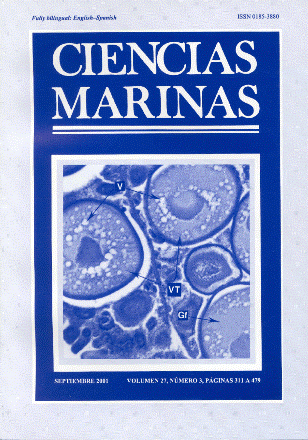Total lipids, cholesterol and plasmatic riglycerides in California sea lion pups (Zalophus californianus)
Main Article Content
Abstract
The concentrations of total lipids, cholesterol and plasmatic triglycerides of breeding pups of Zalophus californianus from Los Islotes (Baja California Sur, Mexico) were quantified during the summer of 1999. The contents of total lipids and cholesterol were similar between females and males, with a range of 0.056–0.061 mg/dL and 108–240 mg/dL, respectively. The maximum value of cholesterol found in males belonged to those with smaller weight (240 mg/dL: 8.1 kg); in females, the opposite occurred (112 mg/dL: 14.1 kg). A similar behavior was observed when cholesterol was compared to the thickness of the fat layer. Triglyceride values were very heterogeneous in both females and males, since these values are strongly influenced by the different fasting periods of the pups and because these levels rise during the nutritious lipemia, ranging from 11 to 306 mg/dL in females and from 15 to 232 mg/dL in males. The correlation between morphometric measurements and the clinical parameters was very low. A greater correlation was detected between cholesterol and weight in females; in males it was almost null. No correlation was detected between triglycerides and the morphometric measurements studied. The population at Los Islotes has shown good status during the last four breeding seasons (steady pup production, high pup body condition, stable female fecundity), and during the 1999 sampling, pup body conditions were within the normal values estimated for the Gulf of California in regard to axillary girth, sculp thickness and Fulton´ s condition factor. For these reasons, we consider that triglycerides and cholesterol in pup plasma circa two months old could provide a reference framework for subsequent comparative studies, particularly during periods of environmental stress, such as El Niño.
Downloads
Article Details
This is an open access article distributed under a Creative Commons Attribution 4.0 License, which allows you to share and adapt the work, as long as you give appropriate credit to the original author(s) and the source, provide a link to the Creative Commons license, and indicate if changes were made. Figures, tables and other elements in the article are included in the article’s CC BY 4.0 license, unless otherwise indicated. The journal title is protected by copyrights and not subject to this license. Full license deed can be viewed here.

